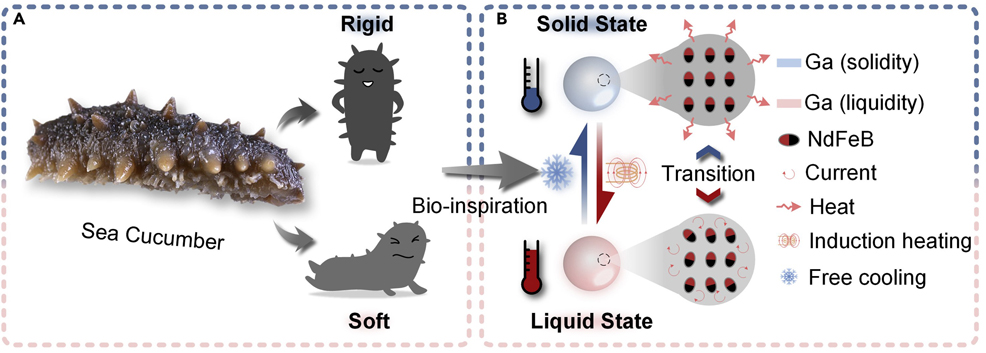
29th January 2023 Shape-shifting robot developed in China Engineers at the Chinese University of Hong Kong have designed tiny robots able to rapidly shift between liquid and solid states. The devices could be used to fix electronics or remove objects from the human body.
Inspired by sea cucumbers, engineers have designed miniature robots able to rapidly and reversibly shift between liquid and solid states. On top of being able to shape-shift, the robots are magnetic and can conduct electricity. To demonstrate the robots' capabilities, researchers put them through an obstacle course of mobility and shape-morphing tests. The study is published this week in the journal Matter. Whereas traditional robots are hard-bodied and stiff, so-called "soft" robots have the opposite problem: they are flexible but weak, and their movements are difficult to control. Giving robots the ability to switch between liquid and solid states endows them with more functionality, according to Chengfeng Pan, who led the study and is an engineer at The Chinese University of Hong Kong. Pan's team designed a new phase-shifting material – dubbed "magnetoactive solid-liquid phase transitional matter" – by embedding magnetic particles in gallium, a metal with a very low melting point of only 29.8 °C (85.6 °F). "The magnetic particles here have two roles," explains Carmel Majidi, mechanical engineer and senior author. "One is that they make the material responsive to an alternating magnetic field, so you can, through induction, heat up the material and cause the phase change. But the magnetic particles also give the robots mobility and the ability to move in response to the magnetic field." By contrast, existing phase-shifting materials rely on heat guns, electrical currents, or other external heat sources to induce solid-to-liquid transformation. The new material also boasts an extremely fluid liquid phase, compared to previous materials whose "liquid" phases are considerably more viscous.
The researchers tested their material's flexibility and strength in a variety of contexts. Using a magnetic field, the robots crossed obstacles, climbed up walls and even split in half to cooperatively move other objects around before coalescing back together. In one video, a robot shaped like a Lego man liquifies to ooze through a grid, after which it remoulds back into its original shape. Fans of Terminator 2 will see the obvious resemblance with its main antagonist – the T-1000, a shape-shifting assassin robot that uses liquid metal to morph and disguise itself or create deadly weapons. In one pivotal scene, it enters a mental hospital by walking through prison bars. While the kind of technology depicted in that movie is likely many decades or even centuries away, phase-shifting materials like that developed in this study could have many practical (and non-lethal) applications in the nearer term. On the biomedical side, for example, the team used one of their robots to remove a foreign object from a model stomach, and to deliver drugs on-demand into the same stomach. They also demonstrated how the material could work as "smart soldering" robots for wireless circuit assembly and repair (by oozing into hard-to-reach circuits and acting as both solder and conductor) and as a "universal" mechanical screw for assembling parts in hard-to-reach spaces (by melting into the threaded screw socket and then solidifying; no actual screwing required). "We're pushing this material system in more practical ways to solve some very specific medical and engineering problems," said Pan. "Future work should further explore how these robots could be used in a biomedical context," says Majidi. "What we're showing are just one-off demonstrations, proofs of concept, but much more study will be required to delve into how this could actually be used for drug delivery or for removing foreign objects."
Comments »
If you enjoyed this article, please consider sharing it:
|







